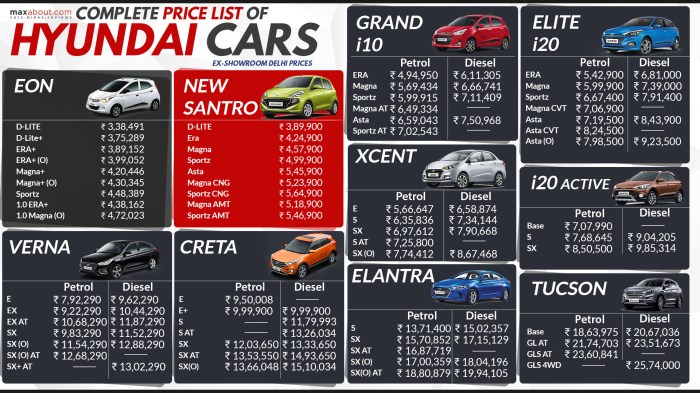Best New Car Price Guide Your Buying Companion
Understanding “Best New Car Price Guide” User Intent
Best new car price guide – Understanding user intent is crucial for creating a truly effective new car price guide. Different users approach such a guide with varying needs and motivations. Analyzing these user segments allows for a tailored and optimized user experience.
Finding the best new car price guide can be challenging, especially with fluctuating market conditions. A significant factor impacting pricing, as seen recently with the tesla new car price drop , highlights the importance of staying updated. Therefore, regularly consulting reliable price guides is crucial for securing the best possible deal on your next vehicle purchase.
User Segmentation and Motivations
Several distinct user segments can be identified when considering searches for “best new car price guide”. Each segment has unique motivations and information needs.
- The Budget-Conscious Buyer: This user is primarily focused on finding the best possible deal and is highly sensitive to price. Their motivation is to maximize their purchasing power and get the most car for their money. They need clear, concise pricing information, ideally with options for filtering by price range. A persona for this segment might be Sarah, a young professional saving diligently for her first car, prioritizing affordability and fuel efficiency.
- The Informed Shopper: This user is already well-researched and wants to compare prices across different dealerships and models. Their motivation is to ensure they are getting a fair price and avoiding overpaying. They need detailed price breakdowns, including MSRP, dealer invoice price, and potential discounts. A persona might be Mark, an experienced car buyer who values transparency and wants to leverage price data to negotiate effectively.
- The Feature-Focused Buyer: This user prioritizes specific features and is willing to pay a premium for them. Their motivation is to find the best value for their desired features. They need a price guide that allows them to filter by features and compare prices of cars with similar specifications. A persona could be Emily, a family who needs a large SUV with specific safety features and is willing to pay more for reliability and safety.
Key Features of a Comprehensive Price Guide
A comprehensive price guide must offer several key features to effectively serve its users. The format of the guide (website, app, or print) will influence how these features are presented, but the core elements remain consistent.
Essential Guide Elements and Format Comparisons
Several essential elements contribute to a useful price guide. Websites offer dynamic updates and interactive features, apps provide on-the-go access, while printed guides offer a tangible reference. Each format has its strengths and weaknesses.
- Up-to-date Pricing: Accurate pricing data is paramount, requiring frequent updates to reflect market fluctuations. Websites and apps are better suited for this, due to the ease of updating.
- Detailed Specifications: Clear and comprehensive vehicle specifications are crucial. Websites excel at this, offering detailed descriptions and often interactive configurators.
- Dealer Information: Contact details for local dealerships are essential. Websites can integrate maps and directions, enhancing user experience.
- Search and Filtering Options: Robust search and filtering capabilities are critical. Websites and apps provide superior functionality in this regard.
Visual Representation of Pricing Data
Effective visual representations are key to making price data easily digestible. Interactive charts and graphs, color-coded maps illustrating regional price variations, and clear tables comparing models are all effective options.
Key Features and Benefits
| Feature | Benefit |
|---|---|
| Real-time Price Updates | Ensures users see the most current pricing information. |
| Detailed Car Specifications | Allows users to compare cars based on specific features. |
| Interactive Maps | Helps users locate nearby dealerships. |
| Advanced Search Filters | Enables users to quickly find cars matching their criteria. |
Data Sources and Methodology for Price Determination
Accurate price determination relies on robust data sources and meticulous methodology. Regular updates are vital to reflect dynamic market conditions.
Data Sources and Price Calculation

Source: maxabout.us
Data sources include manufacturer suggested retail prices (MSRP), invoice prices from dealerships, transaction data from sales records, and market analysis reports from automotive industry publications. Price ranges are calculated using statistical methods, considering various factors like trim level, options, location, and time of year. Regional variations are accounted for by analyzing data specific to each region.
Updating the Price Guide
The price guide is updated regularly, typically weekly or even daily for online versions, using automated data feeds and manual verification. Market trends, new model releases, and seasonal variations are all considered in the update process. Regional price differences are addressed through geographically segmented data analysis.
Presenting Price Information Clearly and Concisely
Clear and concise presentation of price information is paramount. Various methods and best practices contribute to user understanding.
Effective Presentation Methods
Utilizing clear and concise language, tables comparing models side-by-side, and interactive charts and graphs showcasing price ranges over time all contribute to better user understanding. A user-friendly interface with intuitive navigation is crucial for easy access to information. Complex pricing details should be clearly explained with supporting examples.
Best Practices for Presenting Complex Pricing Information
- Use clear and concise language.
- Employ visual aids such as charts and graphs.
- Provide detailed explanations of any complex pricing terms.
- Use consistent formatting throughout the guide.
- Allow users to easily filter and sort data.
Additional Value-Added Features
Adding value-added features enhances user engagement and the guide’s overall usefulness. Incorporating relevant data points and interactive tools significantly improves the user experience.
Enhancing the Price Guide
Integrating fuel economy comparisons (using EPA data, displayed as MPG and cost per mile), safety ratings (from organizations like NHTSA and IIHS, represented with star ratings or scores), and aggregated consumer reviews (from sites like Edmunds or Kelley Blue Book, displayed as average ratings with user comments) provides valuable context. Interactive tools like car comparison tools (allowing users to compare specifications and prices of multiple cars side-by-side) and loan calculators (estimating monthly payments based on various loan terms) increase user engagement and decision-making capabilities.
Multimedia content, such as high-resolution images showcasing various car angles and detailed interior views (described with features like “a spacious leather interior with heated seats and a panoramic sunroof”), and 360° virtual tours (allowing users to explore the car’s interior and exterior virtually), would further enrich the user experience.
Addressing Potential Challenges and Limitations: Best New Car Price Guide
Maintaining accuracy and addressing limitations are crucial for a reliable price guide. Transparency about data limitations is essential.
Challenges and Mitigation Strategies, Best new car price guide

Source: co.uk
Maintaining accurate and up-to-date pricing information in a volatile market presents a significant challenge. Fluctuating market conditions, regional price variations, and the constant influx of new models require frequent updates and robust data validation processes. Strategies for mitigation include employing automated data feeds, employing manual verification by trained experts, and incorporating predictive modeling techniques to forecast price trends.
Relying solely on a price guide for car purchasing decisions has limitations; users should also consider factors like personal preferences, test drives, and negotiations with dealerships. Addressing potential biases involves using diverse data sources, employing rigorous statistical methods, and transparently disclosing any limitations or potential biases in the data.
Helpful Answers
How often is the price guide updated?
The frequency of updates depends on market volatility. Ideally, a reliable guide updates at least monthly to reflect current pricing trends.
Does the guide include taxes and fees?
Most guides present base Manufacturer’s Suggested Retail Price (MSRP). Taxes, registration fees, and dealer markups are typically added separately and vary by location.
Can I trust the price guide’s accuracy?
While price guides strive for accuracy, prices are subject to change. Always verify prices directly with dealerships before making a purchase.
What if I don’t see my preferred car model?
Price guides may not list every single model or trim level. Contact the manufacturer or a dealership for specific pricing on less common vehicles.





















